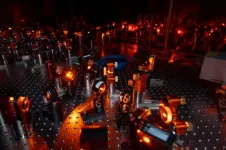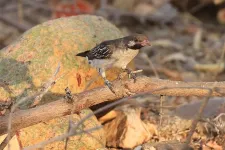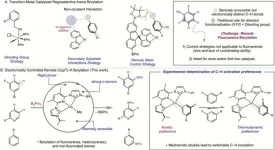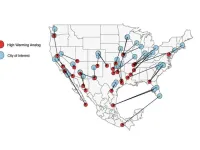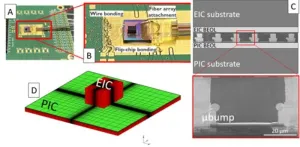(Press-News.org) For the first time, a team of Princeton physicists have been able to link together individual molecules into special states that are quantum mechanically “entangled.” In these bizarre states, the molecules remain correlated with each other—and can interact simultaneously—even if they are miles apart, or indeed, even if they occupy opposite ends of the universe. This research was recently published in the journal Science.
“This is a breakthrough in the world of molecules because of the fundamental importance of quantum entanglement,” said Lawrence Cheuk, assistant professor of physics at Princeton University and the senior author of the paper. “But it is also a breakthrough for practical applications because entangled molecules can be the building blocks for many future applications.”
These include, for example, quantum computers that can solve certain problems much faster than conventional computers, quantum simulators that can model complex materials whose behaviors are difficult to model, and quantum sensors that can measure faster than their traditional counterparts.
“One of the motivations in doing quantum science is that in the practical world it turns out that if you harness the laws of quantum mechanics, you can do a lot better in many areas,” said Connor Holland, a graduate student in the physics department and a co-author on the work.
The ability of quantum devices to outperform classical ones is known as “quantum advantage.” And at the core of quantum advantage are the principles of superposition and quantum entanglement. While a classical computer bit can assume the value of either 0 or 1, quantum bits, called qubits, can simultaneously be in a superposition of 0 and 1. The latter concept, entanglement, is a major cornerstone of quantum mechanics, and occurs when two particles become inextricably linked with each other so that this link persists, even if one particle is light years away from the other particle. It is the phenomenon that Albert Einstein, who at first questioned its validity, described as “spooky action at a distance.” Since then, physicists have demonstrated that entanglement is, in fact, an accurate description of the physical world and how reality is structured.
“Quantum entanglement is a fundamental concept,” said Cheuk, “but it is also the key ingredient that bestows quantum advantage.”
But building quantum advantage and achieving controllable quantum entanglement remains a challenge, not least because engineers and scientists are still unclear about which physical platform is best for creating qubits. In the past decades, many different technologies—such as trapped ions, photons, superconducting circuits, to name only a few—have been explored as candidates for quantum computers and devices. The optimal quantum system or qubit platform could very well depend on the specific application.
Until this experiment, however, molecules had long defied controllable quantum entanglement. But Cheuk and his colleagues found a way, through careful manipulation in the laboratory, to control individual molecules and coax them into these interlocking quantum states. They also believed that molecules have certain advantages—over atoms, for example—that made them especially well-suited for certain applications in quantum information processing and quantum simulation of complex materials. Compared to atoms, for example, molecules have more quantum degrees of freedom and can interact in new ways.
“What this means, in practical terms, is that there are new ways of storing and processing quantum information,” said Yukai Lu, a graduate student in electrical and computer engineering and a co-author of the paper. “For example, a molecule can vibrate and rotate in multiple modes. So, you can use two of these modes to encode a qubit. If the molecular species is polar, two molecules can interact even when spatially separated.”
Nonetheless, molecules have proven notoriously difficult to control in the laboratory because of their complexity. The very degrees of freedom that make them attractive also make them hard to control, or corral, in laboratory settings.
Cheuk and his team addressed many of these challenges through a carefully thought-out experiment. They first picked a molecular species that is both polar and can be cooled with lasers. They then laser-cooled the molecules to ultracold temperatures where quantum mechanics takes centerstage. Individual molecules were then picked up by a complex system of tightly focused laser beams, so-called “optical tweezers.” By engineering the positions of the tweezers, they were able to create large arrays of single molecules and individually position them into any desired one-dimensional configuration. For example, they created isolated pairs of molecules and also defect-free strings of molecules.
Next, they encoded a qubit into a non-rotating and rotating state of the molecule. They were able to show that this molecular qubit remained coherent, that is, it remembered its superposition. In short, the researchers demonstrated the ability to create well-controlled and coherent qubits out of individually controlled molecules.
To entangle the molecules, they had to make the molecule interact. By using a series of microwave pulses, they were able to make individual molecules interact with one another in a coherent fashion. By allowing the interaction to proceed for a precise amount of time, they were able to implement a two-qubit gate that entangled two molecules. This is significant because such an entangling two-qubit gate is a building block for both universal digital quantum computing and for simulation of complex materials.
The potential of this research for investigating different areas of quantum science is large, given the innovative features offered by this new platform of molecular tweezer arrays. In particular, the Princeton team is interested in exploring the physics of many interacting molecules, which can be used to simulate quantum many-body systems where interesting emergent behavior such as novel forms of magnetism can appear.
“Using molecules for quantum science is a new frontier and our demonstration of on-demand entanglement is a key step in demonstrating that molecules can be used as a viable platform for quantum science,” said Cheuk.
In a separate article published in the same issue of Science, an independent research group led by John Doyle and Kang-Kuen Ni at Harvard University and Wolfgang Ketterle at the Massachusetts Institute of Technology achieved similar results.
“The fact that they got the same results verify the reliability of our results,” Cheuk said. “They also show that molecular tweezer arrays are becoming an exciting new platform for quantum science.”
The study, “On-Demand Entanglement of Molecules in a Reconfigurable Optical Tweezer Array,” by Connor M. Holland, Yukai Lu, and Lawrence W. Cheuk was published in Science on December 8, 2023. DOI: 10.1126/science.adf4272
END
Physicists ‘entangle’ individual molecules for the first time, hastening possibilities for quantum information processing
In work that could lead to more robust quantum computing, Princeton researchers have succeeded in forcing molecules into quantum entanglement.
2023-12-07
ELSE PRESS RELEASES FROM THIS DATE:
Wild birds lead people to honey — and learn from them
2023-12-07
Key takeaways
People in parts of Africa communicate with a wild bird, the greater honeyguide, to locate bee colonies and harvest their honey and beeswax.
A study by UCLA anthropologist Brian Wood and other authors show how this partnership is maintained and varies across cultures.
They demonstrate the bird’s ability to learn distinct vocal signals traditionally used by different honey-hunting communities.
In parts of Africa, people communicate with a wild bird — the greater honeyguide — in order to locate bee colonies and harvest their stores of honey and beeswax.
It’s a rare example of ...
Evolving trends in cosmetic breast augmentation: New data
2023-12-07
November 30, 2023 – Ongoing quality improvement data submitted by Board-certified plastic surgeons highlight current trends in surgical technique in cosmetic breast augmentation using implants, reports a study in the December issue of Plastic and Reconstructive Surgery®, the official medical journal of the American Society of Plastic Surgeons (ASPS). The journal is published in the Lippincott portfolio by Wolters Kluwer.
"The findings illustrate evolving trends in breast enhancement over the past 16 years, including factors like the location of the incision and the type and positioning of implants," comments lead author Michael J. Stein, ...
Princeton Chemistry develops catalyst for electronically controlled C–H functionalization
2023-12-07
The Chirik Group at the Princeton Department of Chemistry is chipping away at one of the great challenges of metal-catalyzed C–H functionalization with a new method that uses a cobalt catalyst to differentiate between bonds in fluoroarenes, functionalizing them based on their intrinsic electronic properties.
In a paper published this week in Science, researchers show they are able to bypass the need for steric control and directing groups to induce cobalt-catalyzed borylation that is meta-selective.
The lab’s research ...
Llama power: Tiny llama nanobodies neutralize different noroviruses. Can they improve human anti-viral therapies?
2023-12-07
Human noroviruses cause acute gastroenteritis, a global health problem for which there are no vaccines or antiviral drugs. Although most healthy patients recover completely from the infection, norovirus can be life-threatening in infants, the elderly and people with underlying diseases. Estimates indicate that human noroviruses cause approximately 684 million illnesses and 212,000 deaths annually.
“Human noroviruses are highly diverse,” said first author Dr. Wilhelm Salmen, a graduate student in Dr. B V Venkataram Prasad’s lab while he was working ...
Less ice on the road leads to more salt in the soil, air, and water
2023-12-07
When temperatures drop and roads get slick, rock salt is an important safety precaution used by individuals, businesses, and local and state governments to keep walkers, cyclists, and drivers safe. However, according to a new scientific review paper from a team of researchers at Virginia Tech and the University of Maryland, the human demand for salt comes at a cost to the environment.
Published in the journal Nature Reviews Earth & Environment with researchers Stanley Grant, Megan Rippy, and Shantanu Bhide from Virginia Tech’s Occoquan Watershed Monitoring Laboratory, ...
Very early treatment of newborns with HIV could result in medication-free remission for many babies
2023-12-07
An unexpectedly high percentage of children, who were born with HIV and started treatment within 48 hours of life, exhibit biomarkers by 2 years of age that may make them eligible to test for medication-free remission, according to a multinational study published in Lancet HIV.
“Moving away from reliance on daily antiretroviral therapy (ART) to control HIV would be a huge improvement to the quality of life of these children,” said Protocol Co-Chair and senior author Ellen Chadwick, MD, former Director of Section ...
Sister climate cities, utility data predict future water, electricity demands
2023-12-07
UNIVERSITY PARK, Pa. – Modern-day Ciudad Mante, Mexico, could help Tampa, Florida, plan for shifting water and electricity demands due to climate change, according to an international team of researchers. Led by Renee Obringer, assistant professor of energy and mineral engineering at Penn State, the researchers used utilities data and climate analogs — contemporary cities with climates close to what other cities are predicted to experience in the future — to assess how climate change may impact residential water and electricity use across 46 cities in the United States.
Their computationally efficient model projected strong regional differences for future water and electricity ...
New target found for treatment of spinal muscular atrophy
2023-12-07
The lab of Yongchao C. Ma, PhD, at Stanley Manne Children’s Research Institute at Ann & Robert H. Lurie Children’s Hospital of Chicago uncovered a novel mechanism that leads to motor neuron degeneration in spinal muscular atrophy (SMA). This discovery offers a new target for treatment that overcomes important limitations of gene therapy and other current therapies for SMA.
SMA is a genetic disease that disrupts the nerve cells that control voluntary muscle movement. Symptoms of motor neuron degeneration could start at as early as 3 months of ...
Mass General Cancer Center researchers present key findings at American Society of Hematology (ASH) Meeting
2023-12-07
Investigators from the Mass General Cancer Center, a part of the Mass General Brigham healthcare system, will present research discoveries and outcomes from clinical trials at the 2023 American Society of Hematology (ASH) Annual Meeting, held December 9-12, 2023 in San Diego.
ASH brings together leading experts in classical and malignant blood diseases to share the latest breakthroughs, clinical studies and research impacting the field and patient care. Mass General Cancer Center researchers will cover a wide range of topics, including ...
Thermal impact of 3D stacking photonic and electronic chips
2023-12-07
Recent advancements in AI and more specifically large language models such as ChatGPT have put a strain on data centers. AI models require huge amounts of data to train, and in order to move data between the processing units and memory, efficient communication links become necessary. For long distance communication, fiber optics has already been the go-to solution for decades. For short distance intra-data center communication, the industry is now also starting to adopt fiber optics due to its great performance compared to classical electrical links. Recent technological developments now even enable the switch from electrical to optical interconnect for very small distances, ...
LAST 30 PRESS RELEASES:
Home fingertip oxygen monitors less accurate for people with darker skin tones
Six weeks in a cast no less effective than surgery for unstable ankle fractures
Precautionary approach to alcohol-free and low alcohol drinks needed to protect public health, say experts
Gas-atomized Ca–Mg alloy powders produce hydrogen simply by adding water — high-efficiency hydrogen generation at room temperature
British redcoat’s lost memoir reveals harsh realities of life as a disabled veteran
World-leading rare earth magnet recycling facility launches in UK
Corday Selden selected for the Oceanography Society Early Career Award
MIT chemists determine the structure of the fuzzy coat that surrounds Tau proteins
Same moves, different terrain: How bacteria navigate complex environments without changing their playbook
Severe weather is deadly for vulnerable older adults long after the storm ends, study finds
Expert panel highlights opportunities for improving cancer studies
Hearing aid prescriptions not associated with changes in memory and thinking
Seth Zippel selected for The Oceanography Society Early Career Award
Jeremy Horowitz selected for The Oceanography Society Early Career Award
Kennesaw State University’s Jerry Mack named Paul “Bear” Bryant Newcomer Coach of the Year
Ancient teeth are treasure troves of data on Iron Age lifestyles
Avocados may become easier to grow in India—but not if global emissions remain high
Pregnant women with IBD show heightened inflammation in vaginal mucosa
Underwater photos show seabirds, seals and fish interacting with a tidal turbine in Washington State
1 in 5 surveyed UK adults who have experienced the death of a pet report it as more distressing than experienced human deaths, with significant rates of prolonged grief disorder symptoms also being re
Polyester microfibers in soil negatively impact the development of cherry tomato plants in experiments, raising concerns over the potential effect of high levels of such contaminants
LGBTQ+ adults may be around twice as likely to be unemployed or to report workforce non-participation compared to heterosexual adults, per large representative Australian survey
Horses can smell fear: In experiments where horses smelled sweat from scared humans, they reacted to scary and sudden events with increased fear and reduced human interaction
New synaptic formation in adolescence challenges conventional views of brain development
Scientists identify target to treat devastating brain disease
Oliver Zielinski selected as Fellow of The Oceanography Society
Has progress stalled on gender equality at work?
Quantum simulator sheds light on how nature moves energy in systems like photosynthesis and solar conversion
Can a hashtag help prevent atrocities? Study shows social media can be a powerful tool
The American Ornithological Society (AOS) announces the winner of the 2025 Wesley Lanyon Award
[Press-News.org] Physicists ‘entangle’ individual molecules for the first time, hastening possibilities for quantum information processingIn work that could lead to more robust quantum computing, Princeton researchers have succeeded in forcing molecules into quantum entanglement.
